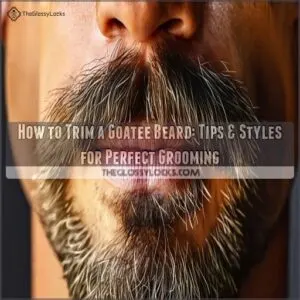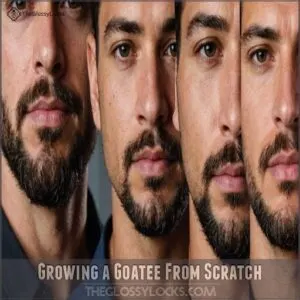This site is supported by our readers. We may earn a commission, at no cost to you, if you purchase through links.
 Want to master your goatee? First, brush it well. Then, using a trimmer, carefully outline your desired shape. Next, use the precision trimmer to refine the edges, paying close attention to where your goatee meets your mustache. Remember to trim shorter hairs to avoid pulling. Clean shaving around the goatee completes the look.
Want to master your goatee? First, brush it well. Then, using a trimmer, carefully outline your desired shape. Next, use the precision trimmer to refine the edges, paying close attention to where your goatee meets your mustache. Remember to trim shorter hairs to avoid pulling. Clean shaving around the goatee completes the look.
Finally, moisturize!
Learning how to trim a goatee beard is easier than you think. But there’s more to it than just trimming – discover the secrets to different goatee styles and keep it looking sharp.
Table Of Contents
- Key Takeaways
- Growing a Goatee From Scratch
- Essential Tools for Trimming a Goatee
- Preparing Your Goatee for Trimming
- How to Trim a Goatee: Step-by-Step Guide
- Trimming and Shaping Your Goatee
- Maintaining a Healthy and Stylish Goatee
- Common Goatee Styles and How to Achieve Them
- Advanced Goatee Styling Techniques
- Troubleshooting Common Goatee Issues
- Frequently Asked Questions (FAQs)
- How to trim a goatee?
- How to trim a full beard to a goatee?
- How do you shave a goatee beard?
- How to trim a beard?
- How far should a goatee go under the chin?
- How to properly trim a goatee?
- How to make a goatee look good?
- How far up the neck do you trim a goatee?
- How can I fix an uneven goatee?
- What should I do if my goatee itches?
- How can I make my goatee look fuller?
- What products prevent goatee hair from frizzing?
- How do I change my goatee style easily?
- Conclusion
Key Takeaways
- Start by gathering essential tools like a trimmer, scissors, and beard oil for a smooth trimming process.
- Define the goatee’s edges using a precision trimmer, shaping the outline around the chin and jawline.
- Maintain your goatee’s style by regularly trimming to an even length and applying beard oil to soften the hair.
- Prevent common issues like itchiness and patchy growth by exfoliating your skin and hydrating with high-quality beard products.
Growing a Goatee From Scratch
When you’re starting to grow a goatee from scratch, patience and preparation are key.
Begin by caring for your skin.
Using beard oil for short beards can help transform sparse beards to lush ones. Choose the right beard oil to encourage healthy growth in just a few weeks.
Preparing Your Skin for Goatee Growth
Preparing for goatee growth is as simple as 1-2-3.
First, exfoliate your skin regularly to keep it fresh and unclogged.
Second, moisturize daily to keep your skin supple and ready for beard magic.
Third, incorporate a skincare routine that includes cleansing and applying a good pre-growth prep.
Follow these steps, and you’ll soon be shaping that perfect goatee!
Choosing The Right Beard Growth Oil
You’ll want a beard oil packed with nourishing ingredients for that goatee.
Consider these factors when choosing the right oil:
| Feature | Option 1 | Option 2 | Option 3 |
|---|---|---|---|
| Oil Ingredients | Argan & Jojoba | Castor & Almond | Tea Tree & Grapeseed |
| Beard Oil Benefits | Softness, shine | Growth stimulation, thickness | Moisturizing, anti-itch |
| Scent | Unscented | Cedarwood | Citrus |
| Oil vs. Balm | Lighter, daily use | Richer, styling | Medium weight, all-around |
| Price | Budget-friendly | Mid-range | Premium |
Apply a few drops daily, massaging it into your skin and beard.
Remember, a little goes a long way!
How to Grow a Goatee in 4-6 Weeks
Growing a goatee in 4-6 weeks is a journey worth taking.
Here’s a plan to guide you:
- Patience is key: Facial hair takes time to grow.
- Beard oil benefits: A beard brush, comb, and regular use of beard styling products can help maintain a healthy and well-groomed beard. Use it to moisturize and promote growth.
- Patchy beard solutions: Trim surrounding areas for defined edges.
- Goatee itch relief: Gently clean and hydrate your face.
Stay consistent!
Common Mistakes to Avoid When Growing a Goatee
Thinking about growing a goatee? Avoid common pitfalls like patchy growth or beard itch!
Overuse of wrong tools and neglecting skin can lead to uneven edges, so focus on goatee maintenance.
Using beard care is key.
| Mistake | Consequence | Solution |
|---|---|---|
| Patchy growth | Uneven appearance | Consistent trimming |
| Beard itch | Discomfort | Use beard oil |
| Wrong tools | Uneven edges | Choose wisely |
| Neglecting skin | Irritation | Moisturize daily |
| Rushing the process | Poor results | Be patient |
Essential Tools for Trimming a Goatee
To keep your goatee looking sharp, you’ll need the right tools like an electric beard trimmer, safety razor, and beard scissors.
Using these, you’ll find it as easy as pie to maintain your stylish look without any hassle.
Electric Beard Trimmers
Once you’ve got your goatee growing nicely, it’s time to talk tools.
An electric beard trimmer is your best buddy for neat beard styles.
Look for features like blade types and trimmer maintenance.
Choosing between cordless or corded models from the best brands provides flexibility.
An electric trimmer can smoothly handle goatee beard trimming with ease.
Safety Razors
Ever tried using a safety razor for your goatee?
It’s all about precision!
With sharp blades, you get clean edges, but don’t forget the shaving cream to prevent razor burn.
Be gentle to avoid skin irritation and dreaded razor bumps.
Regular blade changes are key to avoiding ingrown hairs.
Who said grooming can’t be a breeze?
Voilà, beard trimming made easy!
Beard Scissors
It’s not just about safety razors, those trusty beard scissors are stars in your goatee grooming kit.
Choosing the right beard scissors means picking ones that feel right in your hand.
You can use a beard trimming guide to help you choose the right scissors for your needs, whether you want barber scissors for precise cuts or mustache scissors for detail work.
They’re perfect for those precise trimming techniques.
Unlike trimmers, they offer control for subtle adjustments.
Remember, maintaining beard scissors makes sure they stay sharp and ready for action.
Preparing Your Goatee for Trimming
Before you start trimming, prepping your goatee is key!
Wash, condition, and towel-dry your goatee.
Then apply a bit of beard oil to soften the hairs and make trimming easier—it’ll also help prevent irritation.
Washing and Conditioning Your Goatee
Before you start trimming, focus on goatee hygiene with a solid wash and condition routine.
To keep your goatee healthy and well-groomed, understanding how to care for curly beards, such as using the right tools and products for curly beard care tips, is crucial. Use a beard shampoo designed for facial hair to eliminate dust and debris.
Follow up with a conditioner to keep your goatee soft and healthy.
You might even try a DIY beard wash.
Remember, a well-maintained beard shines bright and trims easy!
Towel-Drying Your Goatee
Pat your goatee dry with a towel, avoiding vigorous rubbing, which can lead to frizz and damage, and consider using a microfiber towel for hair.
Opt for a soft towel to gently squeeze out excess water, reducing drying time.
This is key for goatee care, helping maintain a good shape and dryness.
A well-towel-dried goatee sets the stage for efficient beard shaping and trimming.
Applying Beard Oil for Trimming
Think of beard oil as a secret weapon for smooth trimming.
It softens the hair, making the process effortless.
Apply it to your goatee with these easy steps:
- Choose the right oil type for your facial hair.
- Use sparingly; a few drops do wonders.
- Massage gently, reaching the roots to nourish and moisturize.
How to Trim a Goatee: Step-by-Step Guide
Ready to give your goatee a sharp, stylish look? Follow this step-by-step guide to define your edges, trim your mustache and soul patch, and shape your chin and jawline effortlessly.
Defining The Edges of Your Goatee
Start by using a precision trimmer to carve out your goatee shape.
Gently guide the blade along your neck line and chin line for a crisp edge.
For a closer shave, consider using a beard razor kit, beard razor essentials.
Remember, a steady hand wins the race!
For fine-tuning, go for a razor—it’s perfect for those tricky sideburns.
For perfectly trimmed goatees, consider using a beard care kit with beard oil, such as those found in a Beard Grooming Trimming Kit, to keep your facial hair healthy and stylish. Apply some beard oil after shaving to keep your facial hair grooming game strong.
Trimming The Mustache and Soul Patch
Tackling that mustache and soul patch? Here’s the scoop.
First, determine your ideal mustache length.
Second, pick the right trimming tools: scissors or clippers.
To achieve sharp lines and exact edges, consider using a manual razor for precision shaping, as explained in soul patch trimming techniques.
Third, shape the soul patch to complement your goatee.
Fourth, use blending techniques to smooth changes.
A bit of beard oil or wax adds finesse, ensuring your style inspiration truly shines!
Shaping The Chin and Jawline
Defining your jawline and chin contour is key to a sharp goatee.
Use a trimmer to carefully outline your jawline, creating a clean, defined edge.
Then, shape the chin beard, paying attention to its symmetry.
Experiment with different goatee styles for men to find what best complements your face shape.
Remember, a little beard oil helps keep things soft and manageable.
Enjoy the process of beard shaping!
Trimming and Shaping Your Goatee
When trimming and shaping your goatee, you’ll want to keep it even and well-defined to showcase your style.
Whether you’re using a Goatee Saver template or just your trusty trimmer, make sure the areas around your goatee are shaved clean for a polished look.
Using a Goatee Saver Template
While tackling the edges, consider using a Goatee Saver template for precision.
It’s like a stencil for your face, ensuring your goatee stays symmetrical.
No need to worry about uneven lines anymore!
There are various template types, even DIY options, to fit your style.
Maintain that fresh look with ease, adding flair to your mens grooming routine.
Trimming The Goatee to an Even Length
Got your goatee saver template in hand?
Let’s trim that goatee to an even length.
Grab your trimmers, set them to your desired beard length, and start from one side, moving steadily across your chin.
Make sure to use even strokes for that smooth, balanced look.
A quick tip: a dash of beard oil helps the trimmer glide effortlessly.
Shaving The Areas Around The Goatee
Once your goatee’s evenly trimmed, it’s time to tackle the areas around it.
Use shaving techniques to smoothly clear the cheeks and neck.
Choose a sharp razor to avoid skin irritation.
Start from the cheek line down, keep steady hands, and shape your neckline just above the Adam’s apple.
Remember, a clean shave highlights your goatee beautifully!
Maintaining a Healthy and Stylish Goatee
Keeping your goatee healthy and stylish doesn’t have to be a challenging task; with regular trimming, moisturizing, and a bit of attention, you can make sure it always looks its best.
Think of it as a mini pet that thrives with a little care and grooming—minus the walks, of course!
How to Keep Your Goatee Soft and Manageable
After trimming and shaping, your goatee needs some tender love to stay soft and manageable.
Apply beard oil daily; it moisturizes both your facial hair and the skin beneath, preventing itchiness and dryness.
For added softness, use a beard balm.
These goatee care tips help keep your beard looking sharp, ensuring your facial hair feels as good as it looks.
The Importance of Regular Trimming and Grooming
Keeping your goatee looking sharp isn’t just about aesthetics; it’s about beard health.
Regular trimming prevents that unruly, itchy feeling.
A well-maintained goatee shows you care about your style upkeep.
Think of it as a grooming routine—a small investment for big rewards.
Consistent trimming helps you achieve your desired goatee style, whether it’s a classic full goatee or a trendy anchor style.
Plus, regular maintenance keeps your goatee looking its best, boosting your confidence.
How to Prevent Ingrown Hairs and Irritation
Regular trimming keeps your goatee looking sharp, but don’t let ingrown hairs and irritation steal the spotlight.
Exfoliation is your sidekick here. A gentle scrub twice a week can prevent pesky ingrowns.
For skincare, try beard oil to soften hair and soothe skin.
Use a proper shaving technique to avoid razor burn and acne—your goatee with beard will thank you.
Common Goatee Styles and How to Achieve Them
Discover the art of goatee grooming with styles like the Van Dyke, Anchor, and Chin goatee, each bringing its own flair to your look.
You’ll learn simple tips on how to trim and shape these popular styles, making sure you achieve the perfect finish every time.
The Van Dyke Goatee: a Timeless Classic
With a healthy and stylish goatee in place, let’s explore the Van Dyke goatee, a timeless classic.
Named after the Flemish painter Anthony Van Dyke, this style features a pointed mustache and a disconnected chin beard, offering many variations.
Celebrities love it for its distinct look.
To maintain it, trim regularly and make sure the edges are sharp for standout appeal.
The Anchor Goatee: a Stylish and Versatile Option
Admiring the Van Dyke’s timeless charm leads us to explore the Anchor goatee, a stylishly versatile option.
Whether you’re sculpting it for a square jawline or adding flair to a round face, the Anchor is your goatee for different faces.
Here’s how:
- Trim around the chin.
- Isolate the mustache.
- Maintain a clean cheek line.
The Chin Goatee: a Simple Yet Effective Style
Achieving a chin goatee is as easy as pie.
It suits many face shapes, making it versatile.
Ready to enhance your look?
Trim the sides and leave hair on your chin for a simple style.
Don’t ignore the maintenance routine with grooming products to keep it sharp.
Check the table for style tips:
| Face Shape | Style Tips | Maintenance Routine |
|---|---|---|
| Round | Add some angles | Trim regularly |
| Oval | Keep it balanced | Moderate grooming |
| Square | Round the edges | Use beard oil |
| Heart | Broaden the chin | Regular maintenance |
Advanced Goatee Styling Techniques
When you’re ready to take your goatee to the next level, advanced styling techniques can give you a sharp and polished look.
You’ll learn how to create a defined edge with a razor.
You’ll also learn how to use a trimmer for precise shaping.
And finally, you’ll learn how to style with beard wax or balm to keep everything in place.
How to Create a Defined Edge With a Razor
A razor can give you that super sharp goatee outline. But remember razor safety.
Before you start, consider using a beard oil suitable for your skin type to soften your whiskers, as described in a detailed guide to beard trimming and shaping tutorial.
Here’s how to get a clean edge:
- Make sure your razor’s sharp. A dull blade is a disaster.
- Use shaving cream or gel for a smooth shave.
- Gently stretch your skin taut.
- Shave with the grain for a clean Goatee outline, avoiding nicks. Use a Goatee template if needed.
Using a Trimmer to Achieve a Precise Shape
Having honed defined edges with a razor, grab your trimmer for precise shaping.
When trimming your goatee, keep in mind that growing a full beard can take around 4 months, and consider learning how to cut a ducktail beard for a sleek, pointed end. Opt for the right trimmer blade, using a goatee shape guide to maintain the perfect look.
Watch those edges!
Keeping an even length maintains your style’s on point.
Here’s a quick table to highlight key actions:
| Action | Tool Used | Key Tip |
|---|---|---|
| Trim edges | Trimmer blade | Go slow |
| Shape goatee | Shape guide | Stay steady |
| Even length | Beard comb | Consistent cut |
Styling Your Goatee With Beard Wax or Balm
Styling your goatee with beard wax or balm can transform your look from scruffy to sophisticated.
Here’s how to pick the right product:
- Wax vs. Balm: Wax gives a firmer hold, perfect for shaping. Balm offers moisture and a light hold. Check out a goatee wax vs balm comparison to decide which suits you best goatee care products.
- Wax Application: Warm it in your hands before styling.
- Balm Benefits: Ideal for daily softness and subtle style.
Troubleshooting Common Goatee Issues
Even the best goatee can run into trouble, but don’t worry, you’re not alone.
Mastering the art of beard care can make all the difference, as seen in styles like the ducktail beard guide, which emphasizes patience, precision, and consistent care. Let’s tackle common issues like patchy growth or a scraggly appearance with practical tips that can get your facial hair back on track.
How to Fix Uneven or Patchy Growth
Taming a patchy beard might feel like taming a wild horse, but patience is your best friend.
Embrace beard growth tips like exfoliating and hydrating your skin.
Consider using high-quality beard growth oil products to help nourish and stimulate growth.
Consider beard vitamins to boost growth naturally.
If it’s more stubborn than a mule, explore hair transplant or laser treatment options.
Remember, every great beard has a rough beginning!
Dealing With Ingrown Hairs and Irritation
Your goatee deserves tender care to sidestep ingrown hairs and irritation.
Start by gently exfoliating your skin twice a week.
This helps prevent pesky ingrown hairs.
Add beard oil to your daily routine for its soothing benefits—relieving irritation and keeping your skin smooth.
When shaving, use gentle techniques and a sharp razor.
Embrace these tips, and your goatee will thank you!
How to Prevent Your Goatee From Looking Scraggly
Ever feel like your goatee has a mind of its own, looking more like a wild bush than a sleek style?
Tame it with these goatee grooming tips.
Trim regularly to maintain shape.
Use beard oil to keep it soft and manageable.
And don’t forget a patchy beard fix with targeted growth oils.
Your goatee will thank you!
Frequently Asked Questions (FAQs)
How to trim a goatee?
Grooming greatness begins by gathering gear.
Use a sharp trimmer to define your goatee’s edges; keep it clean and clear.
Trim regularly, maintain even length, and shave cheek stubble.
Embrace precision, patience, and perhaps a pinch of panache!
How to trim a full beard to a goatee?
Start by combing out your full beard.
Using a trimmer, define the edges of where you want the goatee, typically around the mouth and chin.
Shave the rest of the beard, leaving a well-defined goatee.
How do you shave a goatee beard?
Picture trimming your goatee like crafting a masterpiece.
First, gather a razor, clear shaving gel, and a trimmer.
Outline your design, shave around the pattern, and trim to desired length.
Keep it neat with regular upkeep.
How to trim a beard?
To trim your beard, use a comb and scissors to define the shape.
Trim longer hairs with a trimmer set to your desired length.
Tackle stray hairs and finish with beard oil for a polished look.
How far should a goatee go under the chin?
Think of your goatee like the hem of a well-tailored suit.
Ideally, it should stop two to three fingers above your Adam’s apple.
This keeps it neat and balances your facial features smoothly.
How to properly trim a goatee?
First, let your goatee grow for a couple of weeks.
Then, use a sharp razor or trimmer to define its edges.
Trim to your desired length, keeping it neat.
Regularly maintain its shape for a sharp look.
How to make a goatee look good?
With 68% of men wearing facial hair, making your goatee shine is important!
Use beard oil for a sleek look.
Trim regularly for shape.
Wash with beard shampoo to keep it fresh and defined.
How far up the neck do you trim a goatee?
Trim your goatee about two to three fingers’ width above your Adam’s apple.
This creates a neat, defined look that highlights your jawline without overwhelming it.
Use a clear shaving gel for precise trimming.
How can I fix an uneven goatee?
Got an uneven goatee? No biggie!
Grab your trusty trimmer or scissors.
Even out any long spots to your preferred length.
Use a vertical mirror angle to spot-check symmetry and adjust until satisfied.
Happy trimming!
What should I do if my goatee itches?
If your goatee itches, start by washing it with a gentle beard shampoo to remove debris.
Use a beard conditioner to soften the hair, then apply beard oil to moisturize the skin underneath and reduce itchiness.
How can I make my goatee look fuller?
To make your goatee look fuller, use a beard brush daily to distribute oils and improve texture.
Apply beard oil or balm for hydration, and consider dyeing lighter hairs.
Trim regularly to maintain a sharp, defined shape.
What products prevent goatee hair from frizzing?
When taming the wild beast that’s frizzy goatee hair, use beard oil or balm to moisturize and soften.
Pick a beard shampoo and conditioner to cleanse and hydrate, keeping your goatee smooth and tidy.
How do I change my goatee style easily?
Use a mirror and sharp trimmers. Try a different shape; maybe longer, shorter, or even a different style altogether. It’s your face, so have fun with it!
Conclusion
Crafting your ideal goatee isn’t rocket science; it’s all about knowing how to trim a goatee beard with confidence.
Armed with the right tools and techniques, you can shape and maintain a style that suits your face.
From understanding different goatee styles to regular trims, each step is essential in avoiding pitfalls like uneven growth.
Remember, a well-maintained goatee can be your best accessory, giving you that polished, suave look you’re aiming for.














